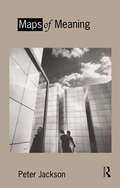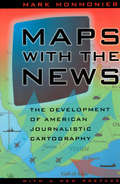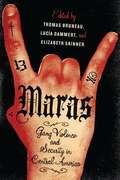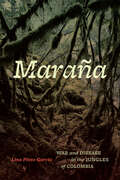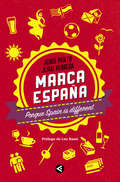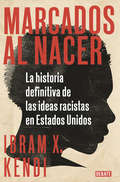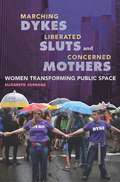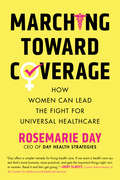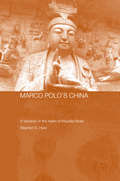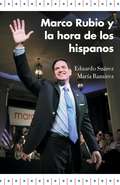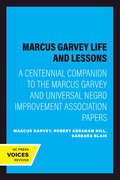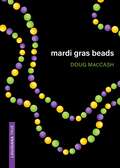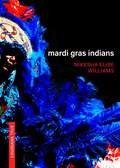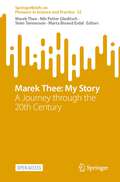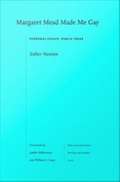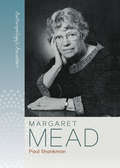- Table View
- List View
Maps of Meaning: An Introduction To Cultural Geography (Contours Ser. #Vol. 1)
by Peter JacksonThis innovative book marks a significant departure from tradition anlayses of the evolution of cultural landscapes and the interpretation of past environments. Maps of Meaning proposes a new agenda for cultural geography, one set squarely in the context of contemporary social and cultural theory. Notions of place and space are explored through the study of elite and popular cultures, gender and sexuality, race, language and ideology. Questioning the ways in which we invest the world with meaning, the book is an introduction to both culture's geographies and the geography of culture.
Maps of Quality of Life in Argentina Since the 19th Century (The Latin American Studies Book Series)
by Juan Pablo Celemin Guillermo Angel VelázquezThe book is presented as an Atlas where the map plays a fundamental role in the study of quality of life, as it shows its progression in Argentina from the 19th to the 21st Century. In the book, it can be observed how the concept has evolved along with the dimensions and variables that better represent its spatial distribution. This is one of the original points of the book: the temporal study of the living conditions of the argentine population, empirically and spatially, emphasizing their territorial representation. Although the book maintains the same socioeconomic dimensions (education, health and housing), the tour through the different chapters offers a historical window that allows the reader to know what the forms of information collection were like in different historical moments. This book is written for geographers and members of the scientific community interested in the study of the well-being of the population. It also allows us to observe the evolution of the quality of life from the 19th century to the 21st, so it may be of interest to historians as well.
Maps with the News: The Development of American Journalistic Cartography (John D. And Catherine T. Macarthur Foundation Series On Mental Health And Development)
by Mark MonmonierMaps with the News is a lively assessment of the role of cartography in American journalism. Tracing the use of maps in American news reporting from the eighteenth century to the 1980s, Mark Monmonier explores why and how journalistic maps have achieved such importance. "A most welcome and thorough investigation of a neglected aspect of both the history of cartography and modern cartographic practice."—Mapline "A well-written, scholarly treatment of journalistic cartography. . . . It is well researched, thoroughly indexed and referenced . . . amply illustrated."—Judith A. Tyner, Imago Mundi "There is little doubt that Maps with the News should be part of the training and on the desks of all those concerned with producing maps for mass consumption, and also on the bookshelves of all journalists, graphic artists, historians of cartography, and geographic educators."—W. G. V. Balchin, Geographical Journal "A definitive work on journalistic cartography."—Virginia Chipperfield, Society of University Cartographers Bulletin
Maras
by Elizabeth Skinner Thomas Bruneau Lucéa DammertSensational headlines have publicized the drug trafficking, brutal violence, and other organized crime elements associated with Central America's mara gangs, but there have been few clear-eyed analyses of the history, hierarchies, and future of the mara phenomenon. The first book to look specifically at the Central American gang problem by drawing on the perspectives of researchers from different disciplinary backgrounds, Maras: Gang Violence and Security in Central America provides much-needed insight. These essays trace the development of the gangs, from Mara Salvatrucha to the 18th Street Gang, in Los Angeles and their spread to El Salvador, Honduras, Guatemala, and Nicaragua as the result of members' deportation to Central America; there, they account for high homicide rates and threaten the democratic stability of the region. With expertise in areas ranging from political science to law enforcement and human rights, the contributors also explore the spread of mara violence in the United States. Their findings comprise a complete documentation that spans sexualized violence, case studies of individual gangs, economic factors, varied responses to gang violence, the use of intelligence gathering, the limits of state power, and the role of policy makers. Raising crucial questions for a wide readership, these essays are sure to spark productive international dialogues.
Maraña: War and Disease in the Jungles of Colombia
by Lina Pinto-GarcíaDelves into the relationship between war and disease, focusing on Colombian armed conflict and the skin disease known as cutaneous leishmaniasis. Cutaneous leishmaniasis, transmitted by female sandflies, produces skin lesions of varying size and shape. In Colombia, the insect vector of the disease is native to the same forested environments that have served as the main stage for one of the longest and most violent wars in Latin American history. As a result, the populations most affected by leishmaniasis in Colombia are members of the state army and nonstate armed groups. Lina Pinto-García explores how leishmaniasis and the armed conflict are inextricably connected and mutually reinforcing. Maraña means “tangle” in Spanish but is also commonly used in Colombia to name the entangled greenery, braided lianas, and dense foliage that characterize the tropical forests where leishmaniasis transmission typically occurs. Pinto-García argues that leishmaniasis and the war are not merely linked but enmarañadas to each other through narratives, technologies, and practices produced by the state, medicine, biomedical research, and the armed conflict itself. All told, Maraña is a passionate study of how war has shaped the production of scientific knowledge about leishmaniasis and access to its treatments in Colombia.
Marca España
by Jordi MoltóEl ADN ibérico en estado puro. Marca España es una mirada hilarante y ácida sobre los usos y costumbres del español medio. ¿Por qué nos gusta tanto el fútbol? ¿Cuáles son las verdaderas cualidades del macho ibérico? ¿Cómo es posible que en un barrio de Madrid haya más bares que en toda Noruega? ¿Por qué tenemos ese gusto especial por todo lo que es gratis? ¿De dónde le viene el amor por el jamón ibérico y la tortilla de patatas? ¿Cómo se desenvuelve el español en el trabajo? ¿Es verdad que gritamos demasiado? Todo esto y mucho más lo descubrimos en este magnífico libro en el que Jordi Moltó y Juan Herrera nos desvelan con cifras, estudios y mucho humor las verdades y mentiras acerca de los tópicos españoles más comunes. Porque la capacidad de los españoles de reírnos de nosotros mismos ¡también es Marca España!
Marcados al nacer: La historia definitiva de las ideas racistas en Estados Unidos
by Ibram X. KendiEL MEJOR LIBRO PARA ENTENDER CÓMO SE INSTITUCIONALIZA EL RACISMO. GANADOR DEL NATIONAL BOOK AWARD DE NO FICCIÓN EN 2016 Tras la elección de Barack Obama, muchos declararon el inicio de una era postracial. Sin embargo, el pensamiento racista, más sofisticado e insidioso que nunca, sigue profundamente arraigado en la sociedad estadounidense. Tal y como argumenta Ibram X. Kendi-la voz más influyente de la lucha antirracista y uno de los referentes actuales del movimiento #BlackLivesMatter-,aunque las ideas racistas se desarrollan, difunden y consagran muy fácilmente, también se las puede desacreditar. Y esto es lo que se propone con Marcados al nacer, una obra maestra galardonada con el National Book Award que derriba la idea, muy asentada, de que el racismo es consecuencia directa de la ignorancia o el odio. En esta investigación histórica profundamente documentada, Kendi nos demuestra cómo en Estados Unidos las mentes más brillantes de diferentes épocas se han esforzado en crear y perpetuar instituciones racistas y un sistema basado en políticas discriminatorias, para luego generar ideas y actitudes racistas que justifiquen ex post facto la esclavitud y la segregación. Al hablar sin tapujos del racismo y de su turbia historia, este libro nos dota de las herramientas necesarias para desenmascararlo, y se convierte en una lectura indispensable en los tiempos que corren. La crítica ha dicho...«Dado el momento político que atravesamos, este libro debería estar en la estantería de todos los jóvenes que aspiran a cambiar el mundo. No es una lectura agradable, pero la verdad no siempre lo es.»Forbes «Absorbente e implacable.»The Washington Post «Una crónica profunda y a menudo inquietante.»The Atlantic «Una historia asombrosa historia, a la vez rigurosa y accesible.»The New Republic
March 4, anniversary edition: Scientists, Students, and Society (The\mit Press Ser.)
by Jonathan AllenScientists debate the role of scientific research in the military-industrial complex and consider the complicity of academic science in American wars.On March 4, 1969, MIT faculty and students joined together for an extraordinary day of protest. Growing out of the MIT community's anguish over the Vietnam War and concern over the perceived complicity of academic science with the American war machine, the events of March 4 and the days following were a “positive protest”—a forum not only for addressing political and moral priorities but also for mapping out a course of action. Soon afterward, some of the participants founded the Union of Concerned Scientists. This book documents the March 4 protest with transcripts of talks and panel discussions. Speakers included Noam Chomsky, Howard Zinn, Lionel Trilling, and Nobel Laureate George Wald, whose memorable speech, “A Generation in Search of a Future,” was widely circulated. Topics of discussion ranged from general considerations of the intellectuals' political responsibility to specific comments on the Vietnam War and nuclear disarmament. This fiftieth anniversary edition adds a foreword by Kurt Gottfried, a physicist, participant in the March 4 protest, and cofounder of the Union of Concerned Scientists. He writes, forcefully and hopefully, “Fifty years ago, a remarkable awakening was occurring among American scientists about their role in society. This volume offers a fascinating snapshot of that moment on March 4, 1969, and the activities and discussions collected here remain relevant and resonant today.” In an era when many politicians routinely devalue science, we can take inspiration from the March 4 protests.
March, Women, March: Voices Of The Women's Movement From The First Feminist To Votes For Women
by Lucinda Hawksley'A wonderful, inspiring story told with scholarship, passion and wit' – Miriam Margolyes'A must-read' – Independent on SundayWith an introduction by Dr Helen Pankhurst.An illuminating and riveting exploration of the women's movement in Britain, and the extraordinary women behind it.From the passing of the Marriage and Divorce Act in 1857 to all women attaining the vote in 1928, the struggle for suffrage in the United Kingdom was to be fought using the weapons of intellect, searing rhetoric, and violence in the streets. Ordinary women rose up to defy the roles prescribed by their society to become heroes in the battle for equality.Using anecdotes and accounts by both famous and hitherto lesser-known suffragettes and suffragists, March, Women, March explores how the voices of women came to be heard throughout the land in the pursuit of equal voting rights for all women. Lucinda Hawksley brings the main protagonists of the women's movement to life, sharing diary extracts and letters that show the true voices of these women, while their portrayals in literature and art – as well as the media reports of the day – show just how much of an impact these trailblazers made.'An accessible and engaging guide to the original women's movement' – Daily Telegraph
Marcha: Latino Chicago and the Immigrant Rights Movement (Latinos in Chicago and Midwest)
by Leon Fink Elena R. Gutiérrez Nilda Flores-González Xóchitl Bada Frances R. Aparicio José Antonio Arellano David Bleeden Ralph Cintrón Stephen P Davis Caroline Gottschalk Druschke Juan R Martinez Sonia Oliva Irma M Olmedo Amalia Pallares José Perales-Ramos Leonard G Ramírez Michael Rodríguez Muñiz R. Stephen WarnerMarcha is a multidisciplinary survey of the individuals, organizations, and institutions that have given shape and power to the contemporary immigrant rights movement in Chicago. A city with longstanding historic ties to immigrant activism, Chicago has been the scene of a precedent-setting immigrant rights mobilization in 2006 and subsequent mobilizations in 2007 and 2008. Positing Chicago as a microcosm of the immigrant rights movement on national level, these essays plumb an extraordinarily rich set of data regarding recent immigrant rights activities, defining the cause as not just a local quest for citizenship rights, but a panethnic, transnational movement. The result is a timely volume likely to provoke debate and advance the national conversation about immigration in innovative ways.
Marching Dykes, Liberated Sluts, and Concerned Mothers: Women Transforming Public Space
by Elizabeth CurransFrom the Women in Black vigils and Dyke marches to the Million Mom March, women have seized a dynamic role in early twenty-first century protest. The varied demonstrations--whether about gender, sexuality, war, or other issues--share significant characteristics as space-claiming performances in and of themselves beyond their place in any broader movement. Elizabeth Currans blends feminist, queer, and critical race theory with performance studies, political theory, and geography to explore the outcomes and cultural relevance of public protest. Drawing on observation, interviews, and archival and published sources, Currans shows why and how women utilize public protest as a method of participating in contemporary political and cultural dialogues. She also examines how groups treat public space as an important resource and explains the tactics different women protesters use to claim, transform, and hold it. The result is a passionate and pertinent argument that women-organized demonstrations can offer scholars a path to study the relationship of gender and public space in today's political culture.
Marching Toward Coverage: How Women Can Lead the Fight for Universal Healthcare
by Rosemarie DayA lively, clear explanation of the American healthcare reform movement from a noted expert--giving women the tools they need to demand fair and affordable coverage for all peopleHealthcare is one of America's most dysfunctional and confusing industries, and women bear the brunt of the problem when it comes to both access and treatment. Women, who make 80 percent of healthcare decisions for their families, are disproportionately impacted by the complex nature of our healthcare system--but are also uniquely poised to fix it.Founder and CEO of Day Health Strategies Rosemarie Day wants women to recognize their trouble with accessing affordable care as part of a national emergency. Day encourages women throughout the country to share their stories and get involved, and she illustrates how a groundswell of activism, led by everyday women, could create the incentives our political leaders need to change course.Marching Toward Coverage gives women the clear information they need to move this agenda forward by breaking down complicated topics in an accessible manner, like the ACA (Affordable Care Act), preexisting conditions, and employer-sponsored plans. With more than 25 years working in healthcare strategy and related fields, Day helps the average American understand the business of national health reform and lays out a pragmatic path forward, one that recognizes healthcare as a fundamental human right.
Marching to Freedom: The Story of Martin Luther King, Jr. (Famous Lives)
by Joyce MiltonA biography of the Baptist minister and civil rights leader whose practice of nonviolent civil disobedience helped African Americans win many battles for equal rights.
Marcial Maciel: Historia de un criminal
by Carmen AristeguiMaciel es un símbolo de la corrupción de la Iglesia y de un cura y empresario. Los graves delitos serán siempre recordados. El caso de Maciel simboliza tantas cosas en este país que es indispensable revisarlo con detenimiento. La corrupción, la bajeza, el abuso de poder, la inmoralidad, la falta de ética y demás valores han sido rotos en esta historia, pero quizá lo más grave ahora es la impunidad a los culpables. Aunque el Vaticano haya declarado "culpable" a Maciel, con muchos años de retraso, su historia ya representa una grave falta a los valores más esenciales de la Iglesia católica y su filosofía originaria. Carmen Aristegui, también hace ya mucho tiempo, ha seguido el caso Maciel con tenacidad casi obsesiva. Ella puso el tema en los medios y ahora, después de las entrevistas a los hijos ocultos de Maciel, el Vaticano ha reaccionado y parece venir una segunda etapa en el caso. Aunque pareciera que aquí concluye la historia, esto no es así: ahora viene, muy posiblemente, la lucha por el poder y el dinero de los Legionarios de Cristo. La organización que gana millones de dólares será disputada por el propio clero y más corruptelas saldrán a la luz o serán silenciadas.
Marco Island (Images of America)
by Austin J. Bell The Marco Island Historical SocietyMarco Island projects prominently from Florida�s mainland at the peninsula�s southwestern fringe, where the waters of the Everglades and the Gulf of Mexico commingle. Its tropical climate, verdant landscape, unique topography, and abundant wildlife sustained prehistoric Native American cultures for centuries. The first pioneer settlers arrived in 1870, carving out a niche on the harsh Florida frontier. Bustling villages soon sprang up on the island, bolstered by strong leaders and economies centered around farming and fishing. The crash of Florida�s land boom, along with the Great Depression, devastating hurricanes, and a series of failed developments, ultimately stunted the island�s growth. Most of Marco Island was sold to the Deltona Corporation in 1964, which transformed the island into a place its early residents might find unrecognizable. Despite Marco Island�s common distinction as the largest of Florida�s Ten Thousand Islands, there are only 12 square miles of land upon which to wander�making the enormity of its history all the more remarkable.
Marco Polo's China: A Venetian in the Realm of Khubilai Khan (Routledge Studies in the Early History of Asia #Vol. 3)
by Stephen G. HawMarco Polo’s famous book about his journey to China, written in 1298, continues to be a subject of considerable controversy. One recent work on the subject argues that Marco Polo never went to China at all, and other scholars have pointed out apparent mistakes and important omissions in Marco’s writings, including his failure to mention the Great Wall, and his apparently erroneous description of the course of the Yellow River. Haw re-examines Marco Polo’s writings. The main arguments against his credibility have been negative, concentrating on things that it is argued he should have seen and noted but did not. The most serious of these supposed omissions are generally said to be his failure to describe the Chinese writing system, tea, foot-binding and the Great Wall of China. Yet Haw argues that what he does mention is impressive and argues strongly for his veracity. This book clarifies Marco Polo’s itineraries in China and proposes several new identifications of places mentioned. Relying extensively on original Chinese sources and supplemented by Haw’s wide knowledge of China, Marco Polo’s China presents a convincing argument and concludes that his work is an accurate, important and useful source from an extraordinary period of Chinese history.
Marco Rubio y la hora de los hispanos
by Eduardo SuárezMarco Rubio es el primer hispano en la historia con serias opciones de llegar a la Casa Blanca. Hijo de inmigrantes que huyeron de Cuba antes de la llegada del castrismo y que se quedaron a medio camino de hacer realidad el sueño americano, Rubio es una figura con una fuerte carga simbólica. Su padre nunca pasó de camarero y su madre limpiaba hoteles en Las Vegas o Miami, pero Marco se interesó desde adolescente por la política escuchando a un abuelo que admiraba a Ronald Reagan. Se graduó en la universidad e hizo carrera política desde los cargos más modestos en Miami. Su ascenso dentro del partido republicano tiene que ver con su capacidad retórica y su habilidad para adaptarse a cualquier situación. Llegó al Senado como uno de los favoritos del sector más conservador y poco a poco se ha ido moviendo hacia posiciones más centristas, abanderando la reforma migratoria que podría legalizar a millones de inmigrantes indocumentados. Su trayectoria simboliza de modo inmejorable el auge de la comunidad hispana, y permite retratar a la vez a un joven y ambicioso político y a la joven y ambiciosa comunidad a la que representa, para ofrecer una imagen poliédrica del país más importante del mundo y el papel que los hispanos desempeñan allí.
Marconi's Wireless and the Rhetoric of a New Technology
by Aaron ToscanoThis book examines the discourse surrounding the wireless, created by the Anglo-Italian inventor Guglielmo Marconi. The wireless excited early twentieth-century audiences before it even became a viable black box technology. The wireless adhered to modernist values--speed, efficiency, militarization, and progress. Language surrounding the wireless is a form of technical communication, overlooked by today's practitioners. This book establishes a broader definition for technical communication by examining a selection of the discourse surrounding Marconi's wireless. The book's main themes are the following: 1) technical communication is all discourse surrounding technology, 2) the field of technical communication (or technical writing) should incorporate analyses of discourse surrounding technologies into its epistemology, 3) the wireless is a product of the society from which it comes (early twentieth-century Western civilization), and 4) the discourse surrounding the wireless is infused with tropes of progress--speed, efficiency, evolution, and ahistoricity.
Marcus Garvey Life and Lessons: A Centennial Companion to the Marcus Garvey and Universal Negro Improvement Association Papers
by Marcus Garvey"I do not speak carelessly or recklessly but with a definite object of helping the people, especially those of my race, to know, to understand, and to realize themselves."—Marcus Garvey, Halifax, Nova Scotia, 1937A popular companion to the scholarly edition of The Marcus Garvey and Universal Negro Improvement Association Papers, this volume is a collection of autobiographical and philosophical works produced by Garvey in the period from his imprisonment in Atlanta to his death in London in 1940.
Mardi Gras Beads (Louisiana True)
by Doug MacCashBeads are one of the great New Orleans symbols, as much a signifier of the city as a pot of scarlet crawfish or a jazzman’s trumpet. They are Louisiana’s version of the Hawaiian lei, strung around tourists’ and conventioneers’ necks to demonstrate enthusiasm for the city. The first in a new LSU Press series exploring facets of Louisiana’s iconic culture, Mardi Gras Beads delves into the history of this celebrated New Orleans artifact, explaining how Mardi Gras beads came to be in the first place and how they grew to have such an outsize presence in New Orleans celebrations.Beads are a big business based on valuelessness. Approximately 130 shipping containers, each filled with 40,000 pounds of Chinese-made beads and other baubles, arrive at New Orleans’s biggest Mardi Gras throw importer each Carnival season. Beads are an unnatural part of the natural landscape, persistently dangling from the trees along parade routes like Spanish moss. They clutter the doorknobs of the city, sway behind its rearview mirrors, test the load-bearing strength of its attic rafters, and clog its all-important rainwater removal system.Mardi Gras Beads traces the history of these parade trinkets from their origins before World War One through their ascent to the premier parade catchable by the Depression era. Veteran Mardi Gras reporter Doug MacCash explores the manufacture of Mardi Gras beads in places as far-flung as the Sudetenland, India, and Japan, and traces the shift away from glass beads to the modern, disposable plastic versions. Mardi Gras Beads concludes in the era of coronavirus, when parades (and therefore bead throwing) were temporarily suspended because of health concerns, and considers the future of biodegradable Mardi Gras beads in a city ever more threatened by the specter of climate change.
Mardi Gras Indians (Louisiana True)
by Nikesha WilliamsMardi Gras Indians explores how sacred and secular expressions of Carnival throughout the African diaspora came together in a gumbo-sized melting pot to birth one of the most unique traditions celebrating African culture, Indigenous peoples, and Black Americans. Williams ties together the fragments of the ancient traditions with the expressed experiences of the contemporary. From the sangamentos of the Kongolese and the calumets of the various tribes of the lower Mississippi River valley to one-on-one interviews with today’s Black masking tribe members, this book highlights the spirit of resistance and rebellion upon which this culture was built.
Mardi Gras!
by Suzanne M. CoilMardi Gras is America's biggest party. How it came about and how it is put on every year are entertainingly revealed in this photo essay. Readers will learn about Mardi Gras' long and fascinating history, parades, floats, and costumes, Krewes, balls, and royalty, The Mardi Gras Indians, the Courir de Mardi Gras in Cajun Louisiana and many more details of this complex event, celebrated annually by thousands of New Orleans natives and visitors.
Marek Thee: A Journey through the 20th Century (SpringerBriefs on Pioneers in Science and Practice #32)
by Nils Petter Gleditsch Marta Bivand Erdal Stein Tønnesson Marek TheeMarek Thee was a Jewish Polish journalist, scholar, and activist. This book tells his life from narrowly escaping death in the Holocaust to exile in Palestine, where he became attached to the Polish consular service. On his return to Poland in 1950, he worked for the Foreign Ministry and later for the Polish Institute for International Affairs. He served as Head of the Polish delegation to the International Control Commission in Indochina in the late 1950s. In 1968 he lost his job and his Polish citizenship in a nationalistic and antisemitic campaign. He was able to move to Norway where he worked for twenty years at the Peace Research Institute Oslo (PRIO), editing an international quarterly journal, Bulletin of Peace Proposals and doing research on the arms race. In retirement, he continued his research and writing at the Norwegian Human Rights Institute. The book vividly relates the drama of his life in Poland, Palestine, Indochina, and Norway.This is an open access book.
Margaret Mead Made Me Gay: Personal Essays, Public Ideas
by Esther NewtonMargaret Mead Made Me Gay is the intellectual autobiography of cultural anthropologist Esther Newton, a pioneer in gay and lesbian studies. Chronicling the development of her ideas from the excitement of early feminism in the 1960s to friendly critiques of queer theory in the 1990s, this collection covers a range of topics such as why we need more precise sexual vocabularies, why there have been fewer women doing drag than men, and how academia can make itself more hospitable to queers. It brings together such classics as "The Mythic Mannish Lesbian" and "Dick(less) Tracy and the Homecoming Queen" with entirely new work such as "Theater: Gay Anti-Church. " Newton's provocative essays detail a queer academic career while offering a behind-the-scenes view of academic homophobia. In four sections that correspond to major periods and interests in her life--"Drag and Camp," "Lesbian-Feminism," "Butch," and "Queer Anthropology"--the volume reflects her successful struggle to create a body of work that uses cultural anthropology to better understand gender oppression, early feminism, theatricality and performance, and the sexual and erotic dimensions of fieldwork. Combining personal, theoretical, and ethnographic perspectives, Margaret Mead Made Me Gay also includes photographs from Newton's personal and professional life. With wise and revealing discussions of the complex relations between experience and philosophy, the personal and the political, and identities and practices, Margaret Mead Made Me Gay is important for anyone interested in the birth and growth of gay and lesbian studies.
Margaret Mead: Anatomy Of An Anthropological Controversy (Anthropology's Ancestors #1)
by Paul ShankmanTracing Mead’s career as an ethnographer, as the early voice of public anthropology, and as a public figure, this elegantly written biography links the professional and personal sides of her career. The book looks at Mead’s early career through the end of World War II, when she produced her most important anthropological works, as well as her role as a public figure in the post-war period, through the 1960s until her death in 1978. The criticisms of Mead are also discussed and analyzed. This short volume is an ideal starting point for anyone wanting to learn about, arguably, the most famous anthropologist of the twentieth century.
